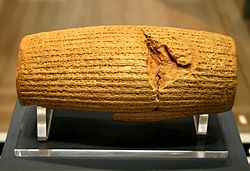Encyclopaedia Britannica Dies Under Its Own
Massive, Printed Weight
And here's an excerpt from another article on the
encyclopedia's crash, written by a former employee of Britannica.com for Inside
Higher Ed:
[Explains, somewhat long-windedly, the reason for the failure]
Those of us who work in higher ed will need to make many transitions to stay relevant in an increasingly global and digital economy. We will have good ideas about how to evolve traditional higher education away from the bundled, place-based, discipline centric institutions that we ourselves were educated in, have spent our lives working for, and that we love. Our success in evolving our institutions, however, will not be determined solely by our ideas for change - but instead by our abilities to execute on these ideas. Will we have the wisdom and skills necessary to evolve our institutions in a global, digital economy?
The rest of the article here.Although I didn't love the article, I could relate immediately to its points. At the cartography workshop hosted by GlobalWork(s) Lab, we discussed the frustrations of having ideas about mapping projects but lacking funding, access, and programming help. Many of us were trying to bring the humanities into digital media but felt like we needed a degree in computer science. Our interests are interdisciplinary, but are skills are not. Even more attendees-- especially faculty-- brought up issues of funding, availability of faculty or student support, pressures of tenure, whether or not a project could count as a publication, and what happens if a project fails. This rather promising conversation came at the end of the day, so very few answers were put forward, but I was relieved to know that I was not alone as someone flailing about and failing to cross borders between fields.
Not mentioned in the workshop, but something I find rather fascinating, is the exhibit of Salman Rushdie's Archive (ended in 2010).
From the curator:
A World Mapped by Stories showcases Rushdie’s belief that reality and the world leave a lot to the imagination, committing the vigilant writer to the task of mapping. For Rushdie this involves a global mindset, creativity with a strong historical sense, the integrity to defend multiple worldviews, and the courage to “point at frauds.” Mapping captures Rushdie’s philosophy of engagement with a storied world, the writer’s creative role in shaping it, and the importance of guarding the freedom to do so. Borrowed from Rushdie’s account of his travels with writer Bruce Chatwin, the title of the exhibition offers a simple but profound message: stories are powerful because we know the world through them. Rushdie’s stories reinvent a world made cynical by injustice and suffering.
Elaine Justice quoted Richart E Luce in her publication about the exhibit: "The Rushdie archive signifies two major trends of our time: the globalization of arts and letters, and the digital world in which contemporary writers and artists, such as Mr. Rushdie, are now composing their masterpieces."
Article here.
Yet through the constant talk of future digitalization and present globalization, a voice speaks up for the artifacts of the past. Physical objects matter, perhaps now more than ever.
In July of 2011, Neil MacGregor (author of A History of the World in 100 Objects and Director of the British Museum, nbd) spoke at TED about a 2600 year-old, cuneiform-inscribed cylinder as "a powerful symbol of religious tolerance and multiculturalism." I would have included words like "site" and "memories" in the little blurb, but oh well. I highly recommend watching the talk:
http://www.ted.com/talks/neil_macgregor_2600_years_of_history_in_one_object.html
It's a rather large, heavy object. Daunting and illegible to the vast, vast majority of us, it hosts stories spanning over two and a half millennia; its meaning has been made and remade through its inscription and provenance. As an object, as a thing, the cylinder tells a story of civilization. Its voice rings out, perhaps ironically, via my laptop, via google search, via the website of TED--short for Technology, Entertainment, Design.


No comments:
Post a Comment